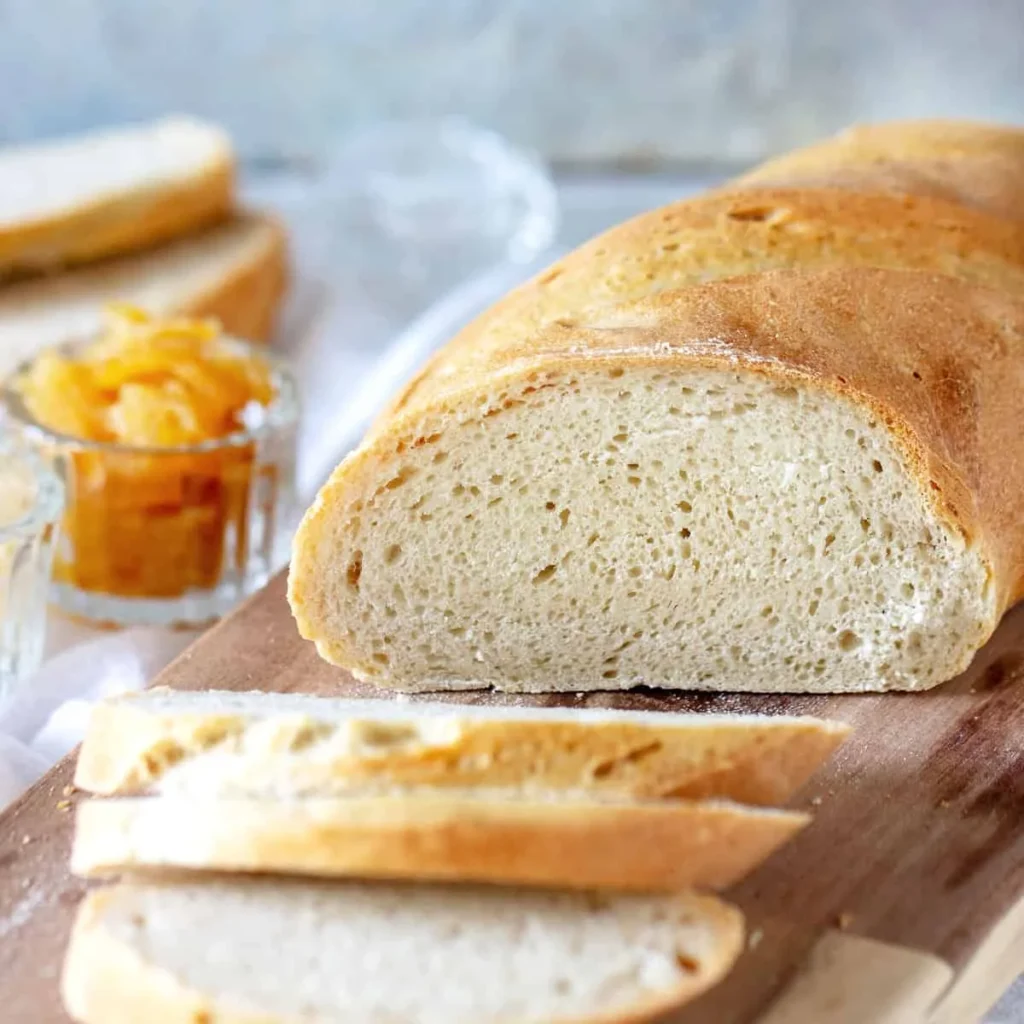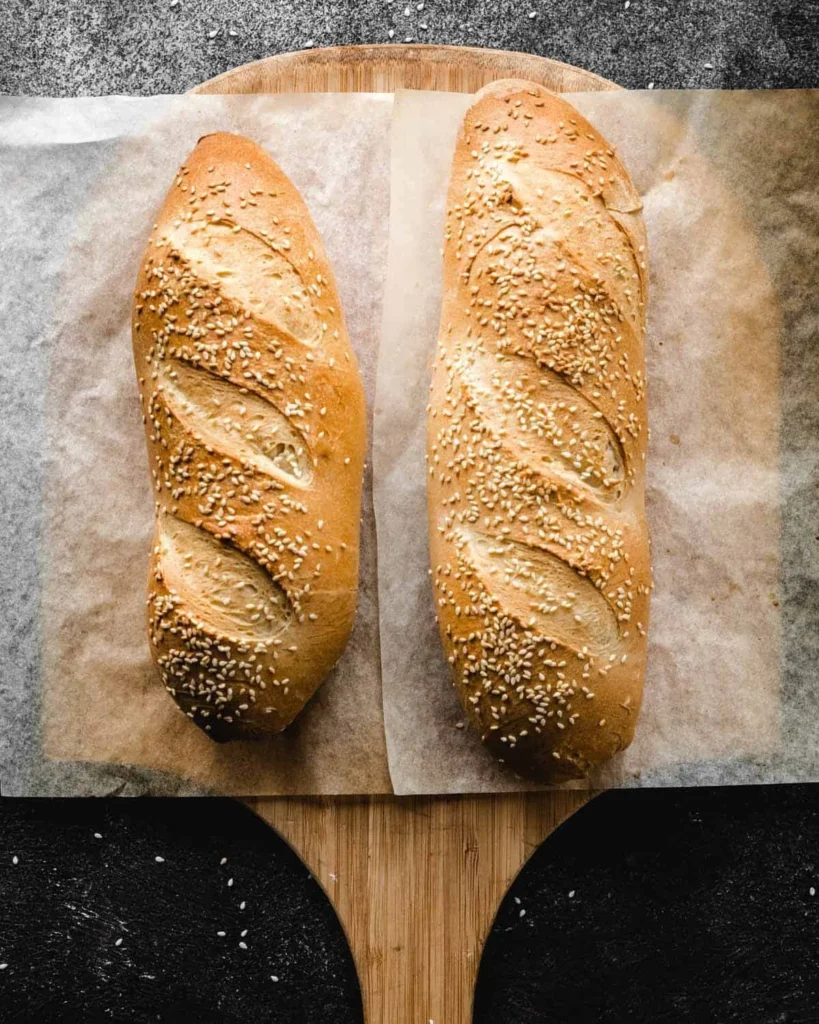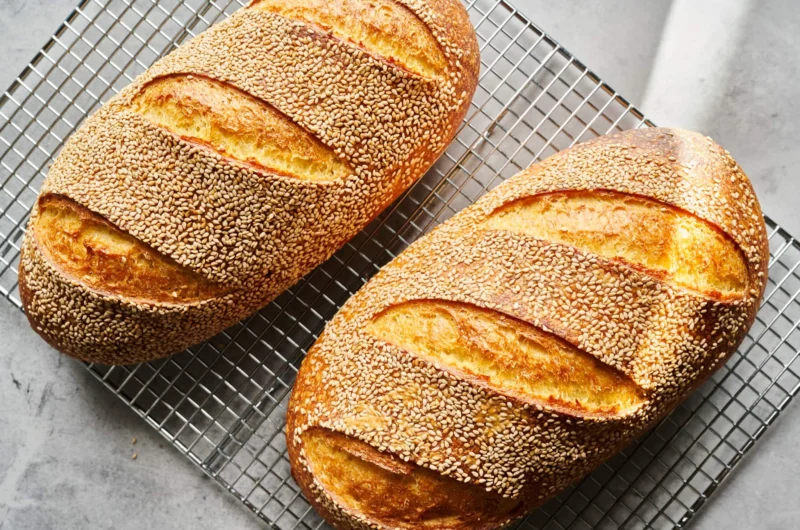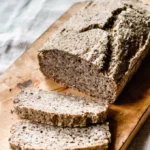Did you know that semolina bread is not only delicious, but also packed with nutrients?
One interesting statistic is that semolina flour, which is the main ingredient in this bread recipe, is high in protein and fiber, making it a healthier option compared to traditional white bread.
But what sets semolina bread apart from others?
Well, in this discussion, we will explore the secrets behind creating a perfectly golden and crusty semolina bread that will leave you craving for more.
Stay tuned to uncover the key steps and ingredients needed to achieve this mouthwatering bread.
Contents
- 1 Key Takeaways
- 2 Ingredients
- 3 Mixing the Dough
- 4 Proofing the Dough
- 5 Shaping the Loaf
- 6 Baking the Bread
- 7 Semolina Bread Recipe
- 8 Enjoying Your Semolina Bread
- 9 Nutritional facts
- 10 Frequently Asked Questions
- 10.1 Can I Substitute Semolina Flour With Another Type of Flour in This Recipe?
- 10.2 Can I Add Additional Ingredients Like Nuts or Seeds to the Dough?
- 10.3 How Long Does the Bread Need to Cool Before Slicing?
- 10.4 Can I Freeze the Semolina Bread for Later Consumption?
- 10.5 How Long Does Semolina Bread Stay Fresh and How Should It Be Stored?
- 11 Conclusion
Key Takeaways
- Semolina bread is a healthy alternative to white bread, as it is high in protein and fiber, and contains essential minerals like iron and calcium.
- It aids in digestion and promotes a healthy gut, thanks to its fiber content.
- Semolina bread has a lower glycemic index compared to white bread, resulting in a slower rise in blood sugar levels.
- Enjoying semolina bread responsibly with different spreads and toppings can enhance its taste and nutritional value.
Ingredients
To make semolina bread, gather the following ingredients. You’ll need 2 cups of semolina flour, 1 cup of all-purpose flour, 2 teaspoons of active dry yeast, 1 teaspoon of salt, 1 tablespoon of sugar, 1 cup of warm water, and 2 tablespoons of olive oil.
Semolina flour, made from durum wheat, offers various health benefits. It’s rich in protein, fiber, and essential minerals like iron and calcium. The high protein content helps in muscle development and repair, while the fiber aids digestion and promotes a healthy gut. Semolina also contains antioxidants that protect against cell damage and boost immunity.
There are different variations of semolina bread recipes that you can explore. For a classic semolina bread, follow the above ingredients and mix them in a large bowl. Knead the dough until smooth and elastic, then let it rise until doubled in size. Shape the dough into a loaf and place it in a greased pan. Allow it to rise again before baking in a preheated oven for about 30 minutes.
For a twist, you can add ingredients like rosemary, olives, or sun-dried tomatoes to the dough. These variations add an extra layer of flavor and create a unique culinary experience. So go ahead and experiment with different combinations to find your favorite semolina bread recipe. Enjoy the freedom to create and savor the delicious results.
Mixing the Dough
Now that you have gathered all the necessary ingredients, it’s time to move on to the next step: mixing the dough for your semolina bread. This crucial step will determine the texture and structure of your bread, so it’s important to follow the instructions carefully. Here are some tips for kneading the dough and troubleshooting common dough mixing problems:
| Tips for Kneading the Dough | Troubleshooting Common Dough Mixing Problems |
|---|---|
| Use a gentle touch when kneading the dough. Over-kneading can result in a dense bread. | If the dough is too dry, add a small amount of water. |
| Stretch and fold the dough to develop gluten. This will give your bread a nice chewy texture. | If the dough is too sticky, add a sprinkle of flour. |
| Knead the dough for about 10-15 minutes, or until it becomes smooth and elastic. | If the dough doesn’t rise, check the yeast or the temperature of the water. |
| Pay attention to the consistency of the dough. It should be slightly tacky but not sticky. | If the dough is not rising enough, give it more time or check the freshness of the yeast. |
Proofing the Dough
Now it’s time to talk about proofing the dough.
Proper proofing conditions are crucial for achieving the best results. You’ll want to ensure that the dough is proofed in a warm, draft-free area to allow for optimal fermentation.
Additionally, the duration of proofing will depend on various factors, such as room temperature and the desired texture of the bread.
Ideal Proofing Conditions
For optimal proofing conditions, ensure that you create an environment that promotes proper fermentation and development of the dough. Here are three essential factors to consider:
- Humidity levels: Maintain a humid environment of around 70-80% to prevent the dough from drying out. This helps to keep the dough moist, allowing it to rise properly.
- Room temperature: Set the room temperature between 75-80°F (24-27°C) to encourage yeast activity. Warmer temperatures can speed up fermentation, while cooler temperatures can slow it down.
- Cover the dough: Place a clean kitchen towel or plastic wrap over the dough while it proofs. This helps to retain moisture and prevent the dough from forming a dry crust.
Duration of Proofing
To ensure the perfect rise and texture of your semolina bread, pay close attention to the duration of proofing the dough. The proofing process is crucial in allowing the dough to rise and develop its flavor. The time required for proofing can vary depending on several factors such as room temperature, dough hydration, and yeast activity. To help you understand the ideal proofing duration for your semolina bread, refer to the table below:
| Proofing Technique | Duration |
|---|---|
| Standard Proofing | 1-2 hours |
| Refrigerator Proofing | 8-24 hours |
| Slow Proofing | 12-48 hours |
Shaping the Loaf
Shape the loaf of semolina bread by gently rolling the dough into a tight ball, ensuring a smooth and rounded surface. This step is crucial in creating a beautiful and professional-looking loaf that will impress both your family and guests.
To help you achieve the perfect shape, here are some tips to keep in mind:
- Use your hands to gently tuck and round the dough, applying just enough pressure to create tension on the surface. This will help the loaf hold its shape during baking.
- Avoid using too much flour while shaping as it can make the dough slippery and difficult to handle. A lightly floured surface is sufficient to prevent sticking.
- Experiment with different shaping techniques to add variety to your bread. Some popular options include braiding, twisting, or forming a rustic boule.
Once you’ve shaped the loaf, it’s time to score the dough. Scoring refers to creating shallow cuts on the surface of the bread before baking. This allows the dough to expand and prevents it from bursting in unexpected places. Use a sharp knife or a bread lame to make the cuts, ensuring they’re deep enough to make a noticeable difference but not too deep to deflate the dough.
Baking the Bread
Now it’s time to bake your semolina bread to perfection.
Preheat your oven to the recommended temperature, usually around 425°F (220°C), and place your bread on a baking sheet or in a preheated dutch oven.
Bake the bread for approximately 25-30 minutes, or until the crust is golden brown and the internal temperature reaches about 200°F (93°C).
Remember to keep an eye on the bread as baking times may vary depending on your oven.
Bread Dough Preparation
Begin by preheating your oven to the specified temperature for baking the bread. Achieving the perfect bread dough consistency is crucial to baking a delicious loaf. Here are some kneading techniques to help you attain that desired texture:
- Stretch and Fold: Gently stretch the dough, then fold it back onto itself. Repeat this process to develop gluten and create elasticity.
- Windowpane Test: Take a small portion of dough and stretch it thin. If it becomes translucent without tearing, the dough is ready.
- Slap and Fold: Slap the dough onto the work surface, then fold it over itself. This technique helps develop gluten quickly.
Semolina Bread Recipe
Course: BreadCuisine: MediterraneanDifficulty: Intermediate8
servings20
minutes30
minutes150
kcalSemolina bread is a traditional Mediterranean bread made with durum wheat semolina, giving it a slightly coarse texture and a nutty flavor. It's perfect for sandwiches or as a side to soups and salads.
Ingredients
Durum wheat semolina
Yeast
Water
Salt
Directions
- Mix semolina, yeast, water, and salt to form a dough.
- Knead the dough until smooth and elastic.
- Let the dough rise until doubled in size.
- Shape the dough into loaves, proof, and bake until golden brown.
Baking Temperature and Time
To ensure a perfectly baked loaf of semolina bread, it’s crucial to carefully consider the baking temperature and time.
The ideal oven settings for baking semolina bread are 425°F (220°C) for the first 10 minutes, then reducing the temperature to 375°F (190°C) for the remainder of the baking time. This initial burst of high heat helps to create a beautiful golden crust while ensuring that the bread rises properly.
The total baking time for a standard-sized loaf is typically around 30-35 minutes. However, it’s important to note that every oven is different, so you should keep a close eye on your bread as it bakes.
You’ll know the bread is done when it has a deep golden crust and sounds hollow when tapped on the bottom. Achieving a golden crust is key to a visually appealing and delicious semolina bread.
Enjoying Your Semolina Bread
Enhance your enjoyment of the delicious Semolina Bread by incorporating different spreads, toppings, or accompaniments. Here are some creative ideas to take your sandwich game to the next level:
- Avocado and Tomato: Spread a generous layer of creamy avocado on a slice of Semolina Bread, then top it with slices of juicy tomato and a sprinkle of salt and pepper. The combination of flavors and textures will leave you craving for more.
- Pesto and Mozzarella: Spread a dollop of homemade or store-bought pesto on a slice of Semolina Bread, then layer it with slices of fresh mozzarella cheese. Add some basil leaves for an extra burst of freshness.
- Smoked Salmon and Cream Cheese: Spread a schmear of cream cheese on a slice of Semolina Bread, then top it with slices of smoked salmon. Add some thinly sliced red onion, capers, and a squeeze of lemon juice for a tangy kick.
Semolina Bread offers health benefits compared to other types of bread. It’s made from durum wheat, which is higher in protein and fiber compared to regular white bread. This means it can help keep you feeling fuller for longer and can aid in digestion.
Additionally, Semolina Bread has a lower glycemic index, which means it causes a slower rise in blood sugar levels compared to refined white bread. So not only does it taste great, but it also provides nutritional benefits that will leave you feeling satisfied and energized.
Enjoy your Semolina Bread with these creative sandwich ideas and feel good about what you’re eating.
Nutritional facts
Calories: Approximately 150 calories
Total Fat: 1.5g
Saturated Fat: 0.2g
Cholesterol: 0mg
Sodium: Varies depending on salt content
Total Carbohydrates: Around 28g
Dietary Fiber: 1.5g
Sugars: Around 1g
Protein: 5g
Frequently Asked Questions
Can I Substitute Semolina Flour With Another Type of Flour in This Recipe?
Yes, you can substitute semolina flour with alternative flours in this recipe. There are various options like all-purpose flour, bread flour, or whole wheat flour that can be used as substitutes depending on your preference.
Can I Add Additional Ingredients Like Nuts or Seeds to the Dough?
Yes, you can definitely add nuts or seeds to the dough. They will enhance the texture and flavor of the bread. You can use different types of nuts or seeds for a variety of tastes.
How Long Does the Bread Need to Cool Before Slicing?
To achieve the perfect slice, let the bread cool for at least 1 hour. This cooling time allows for the flavors to settle and the texture to set. Once cooled, use a sharp knife and a gentle sawing motion for clean, even slices.
Can I Freeze the Semolina Bread for Later Consumption?
Yes, you can freeze the semolina bread for later consumption. The best way to store bread is to wrap it tightly in plastic wrap or aluminum foil before placing it in the freezer.
How Long Does Semolina Bread Stay Fresh and How Should It Be Stored?
Semolina bread stays fresh for about 3-4 days if stored properly. To maximize its longevity, store it in an airtight container or bag in a cool, dry place. Avoid refrigeration as it can make the bread go stale quicker.
Conclusion
In conclusion, creating a semolina bread is a delightful journey that rewards you with a golden, crusty loaf, perfect for any occasion. By following the precise steps of mixing, proofing, shaping, and baking, you’ll achieve a bread that’s both flavorful and satisfying.
So gather your ingredients, roll up your sleeves, and embark on this culinary adventure. Let the aroma of freshly baked bread fill your home, and indulge in the joy of creating something truly special.







